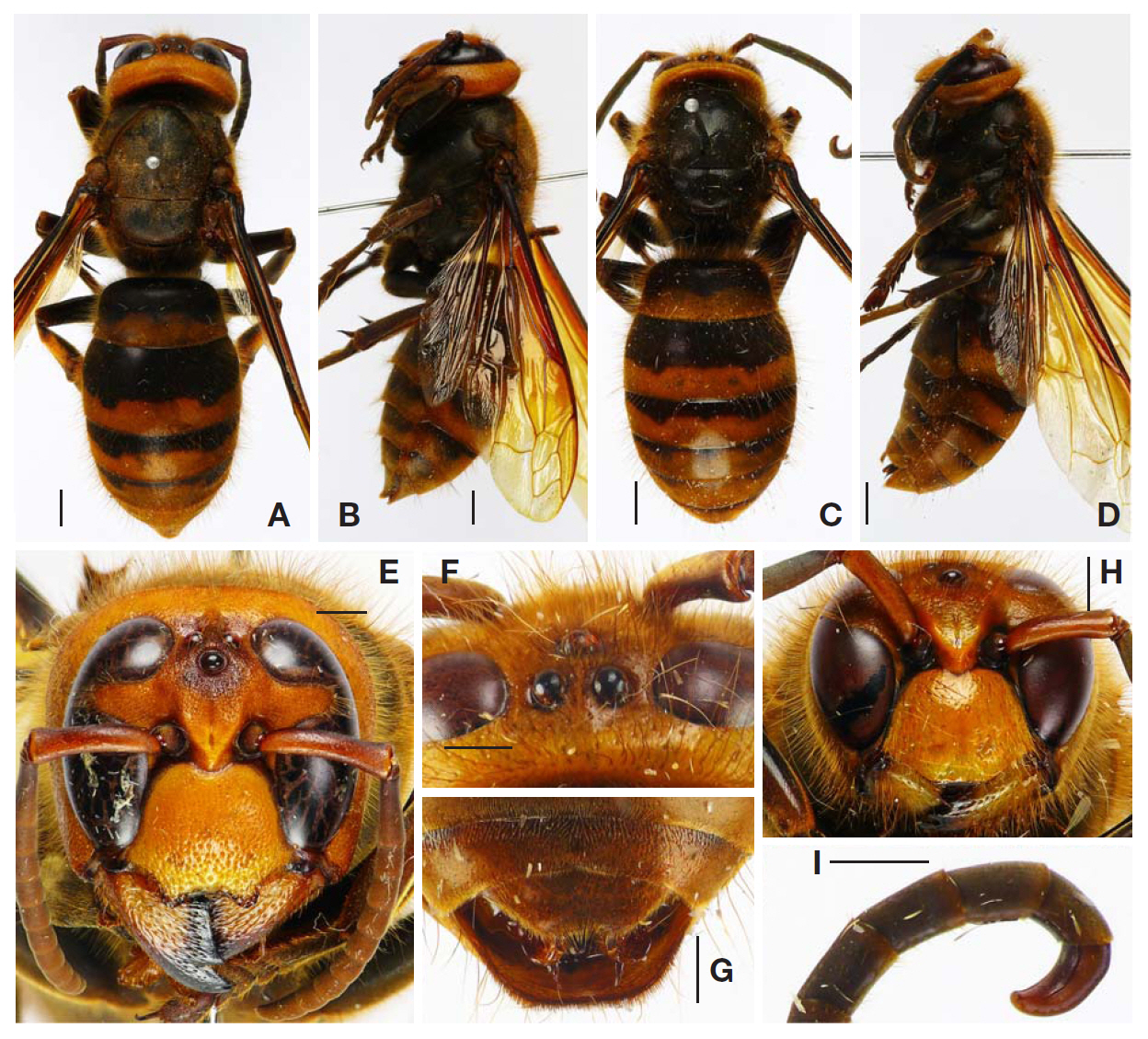



Korean occurrence of
We recently discovered specimens of this distinct species deposited at the Korea National Arboretum (KNA). This species is known to be nocturnal or crepuscular (van der Vecht, 1959), and very easily distinguished from other
This is the second Korean record concerning this species; however, the first report included domestic distributional data. Diagnostic description and digital images of this species are presented.
Order Hymenoptera Linnaeus, 1758
Family Vespidae Latreille, 1902
Genus Vespa Linnaeus, 1758
>
1*Vespa binghami du Buysson, 1905
>
Female (queens and workers).
Body 21.0-31.5 mm long, and forewing 19.0-25.6 mm long (Fig.1 A, B). Ocellus large, its diameter almost as long as the basal breadth of antennal flagellum I; oculus-ocellus distance (shortest distance between inner margin of compound eye and outer margin of posterior ocellus) very short, less than two-thirds of anterior ocellus diameter (Fig.1F). Gena somewhat strongly extended outwardly, its margin visible in frontal view (Fig.1 E); in profile, the ratio of gena width to eye one approximately 1.4 in the broadest portion. Clypeus somewhat strongly swollen, with coarse large dense punctures in its apical half and smaller finer ones in its basal half; its apical margin emarginate (emargination broadly rounded, but much less than semicircular); tips of apical teeth rounded, almost semicircular in shape (Fig.1 E). Pretegula carina complete.
Following parts/markings deep yellow or orange yellow, often partially tinged with ferruginous yellow (Fig.1 A, B). Almost entire face of head including frons, vertex, gena,
clypeus, larger part of mandible except for near apical teeth area. Thick apical bands on metasomal terga Ⅰrior margins of bands sinuous, bands on terga I-Ⅱin apical half, and bands on terga Ⅲmost entire exposed faces. Apical band of sterna Ⅱre face of metasomal segment Ⅵing parts/markings bright ferruginous or reddish: tibiae of all legs, ocellar region, antennae, pronotal tubercle, anterior and posterior margins of pronotal dorsum, posterior margin of scutellum, and disks of terga Ⅲexcept for apical bands area.
Entire body being covered with yellowish (partially somewhat deep yellowish or brownish) dense erect hairs, without blackish ones.
>
Male (based on one specimen).
Body 25.5 mm long, and forewing 21.1 mm long (Fig.1 C, D). Ocelli large as in female, but oculus-ocellus distance longer than one in female, but still shorter than ocellus diameter. Head, in frontal view, much broader than long (Fig.1 H). Gena not strongly extended outwardly as in female, its margin not visible in upper half (Fig.1 H); the ratio of gena width to eye one approximately 1.3. Clypeus broader than high (approximately 1.3 as broad as long) and somewhat polished with fine sparse punctures, especially its median part almost impunctate; clypeal apical margin truncate (Fig.1 H). Lower face of antennal segments ?th tyloids (one on segment ?in shape, and ones on segment ?vering almost entire lower faces); last segment tapering and bent backward, longer than penultimate segment (Fig.1 I). Apicomedian margin of sternum Ⅵy notched; larger median part of sternum Ⅶed, and its apical margin broadly rounded including apicomarginal lamellate plate (Fig.1 G). Coloration and hair condition much as in female.
Korea: Gyeonggi-do: 2♀♀, Gwangneung, 13 Oct 1988, Weon GJ (KNAE0301212002, KNAE 0303262001); 1♀, ditto, 4 Oct 1997, Weon GJ (KNAE030 1212001); 1♀, Gwangneung, Korean National Arboretum, 37°44′54.73N, 127°04′50.09′′E, 17 Aug 2006, Han HJ(KNAE65355); 3♀♀, Gwangneung, Lake Yuklim, 37°44′54.95′′N, 127°90′49.23′′E, 1 Jun 2010, Park SY, Koh KH, Yii KA (KNAE241039, KNAE241094, KNAE241096); 1♀, ditto, 1 Jul 2010, Park SY, Lim JS (KNAE241095); 2♀♀, ditto, 29 Jul 2010, Park SY, Lim JS, Ko KH, Kim KM (KNAE241884, KANE241885); 2♀♀, ditto, 19 Aug 2010, Park SY, Lim JS, Ko KH, Kim KM (KNAE274135, KANE 274136); 1♀, ditto, 6 Sep 2010, Park SY, Lim JS, Ko KH, Kim KM; Gangwon-do: 1♀, Inje-gun, Nam-myeon, Mt.Maebongsan, 37°57′18.4′N, 127°59′55.8′′E, 20 Jul 2010, Park SY, Lim JS, Kim KM; Gyeonggi-do: 1♂, 1♀, Gwangneung, Korean National Arboretum, 33°24′08.54′′N, 126°22′53.18′′E, 12 Oct 2010, Park SY, Lim JS.
India, Bhutan, Myanmar, Thailand, Laos,Vietnam, China, Far Eastern Russia, Korea.
Korean name: 1*큰홑눈말벌
